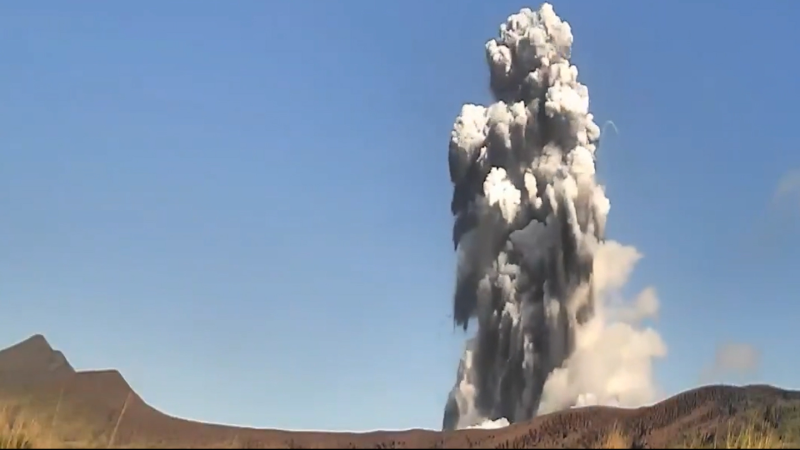How long do we have until sea level rise swallows coastal cities? This fleet of ocean robots will help find out
A team of NASA rocket scientists is developing autonomous underwater robots able to go deep beneath Antarctica’s giant ice shelves to better understand how rapidly ice is melting.

The IceNode robot being deployed in a field test north of Alaska, in March 2024. IceNode can gather data to improve predictions for sea level rise in a warming environment. (Photo credit: NASA via CNN Newsource)
(CNN) — A team of NASA rocket scientists is developing autonomous underwater robots able to go where humans cannot, deep beneath Antarctica’s giant ice shelves. The robots’ task is to better understand how rapidly ice is melting — and how quickly that could cause catastrophic sea level rise.
In March, scientists from NASA’s Jet Propulsion Laboratory lowered a cylindrical robot into the icy waters of the Beaufort Sea north of Alaska to gather data at 100 feet deep. It was the first step in the “IceNode” project.
The ultimate aim is to release a fleet of these robots in Antarctica, which will latch on to the ice and capture data over long periods in one of the most inaccessible places on Earth.
There is an urgent need to better understand this remote, isolated continent; what happens here has global implications.
A slew of recent research suggests Antarctica’s ice may be melting in alarming new ways, meaning the sea level rise forecast might be vastly underestimated. If Antarctica’s ice sheet were to melt entirely, it would cause global sea level rise of around 200 feet — spelling complete catastrophe for coastal communities.
Scientists are particularly keen to understand what’s happening to Antarctica’s ice shelves, huge slabs of floating ice which jut out into the ocean and are an important defense against sea level rise, acting as a cork to hold back glaciers on land.
The “grounding line” — the point at which the glacier rises from the seabed and becomes an ice shelf — is where the most rapid melting may be happening, as warm ocean water eats away at the ice from underneath.
But getting a detailed look at the grounding line in the treacherous Antarctic landscape has been exceptionally difficult.
“We’ve been pondering how to surmount these technological and logistical challenges for years, and we think we’ve found a way,” said Ian Fenty, a climate scientist at JPL and IceNode’s science lead.
NASA’s plan to release around 10 IceNode robots, each around 8 feet long and 10 inches in diameter, into the water from a borehole in the ice or a ship off the coast. They have no propulsion but will ride ocean currents, directed by special software, to their Antarctic destination where they will activate their “landing gear” — three legs which spring out and attach to the ice.
Once in place, their sensors will monitor how fast the warmer, salty ocean water is melting the ice, as well as how quickly the cold meltwater is sinking.
The fleet could operate for up to a year, capturing data across the seasons, NASA said.
Once they have finished monitoring, the robots will detach themselves from the ice, drift to the surface of the ocean and transmit data by satellite. This data can then be fed into computer models to improve the accuracy of sea level rise projections.

An IceNode prototype beneath the frozen surface of Lake Superior, off Michigan's Upper Peninsula, during a field test in 2022. (Photo credit: NASA via CNN Newsource)
“These robots are a platform to bring science instruments to the hardest-to-reach locations on Earth,” said Paul Glick, JPL robotics mechanical engineer and IceNode principal investigator.
The team is currently focused on developing the robots’ technical capabilities and there are more tests planned. There is currently no exact timeline for when they will be deployed in Antarctica, Glick told CNN, “but we’d ideally like it to be as soon as possible.”
Robots have been used to look beneath Antarctica’s ice before. A recent research project used a torpedo-like robot called Icefin, a remotely operated vehicle which recorded information about ocean heat, saltiness and currents.
But where Icefin included a propulsion system and remained attached to a tether, through which it was controlled and could send back data, the IceNodes will be entirely autonomous.
Both systems complement each other, said Rob Larter, a marine geophysicist at the British Antarctic Survey, which was part of the research project using Icefin.
Where Icefin can release data in real time, deployments are limited by how long a borehole can be kept open before freezing over, usually a matter of days. IceNodes will be able to collect data over much longer periods but won’t transmit until its mission is over.
Deployment of both machines is challenging and involves substantial risk to sophisticated equipment, Larter told CNN, “but such innovative approaches and risk taking are necessary to find out more about the critical hidden world beneath ice shelves.”
The-CNN-Wire™ & © 2024 Cable News Network, Inc., a Warner Bros. Discovery Company. All rights reserved.
Report a Typo














